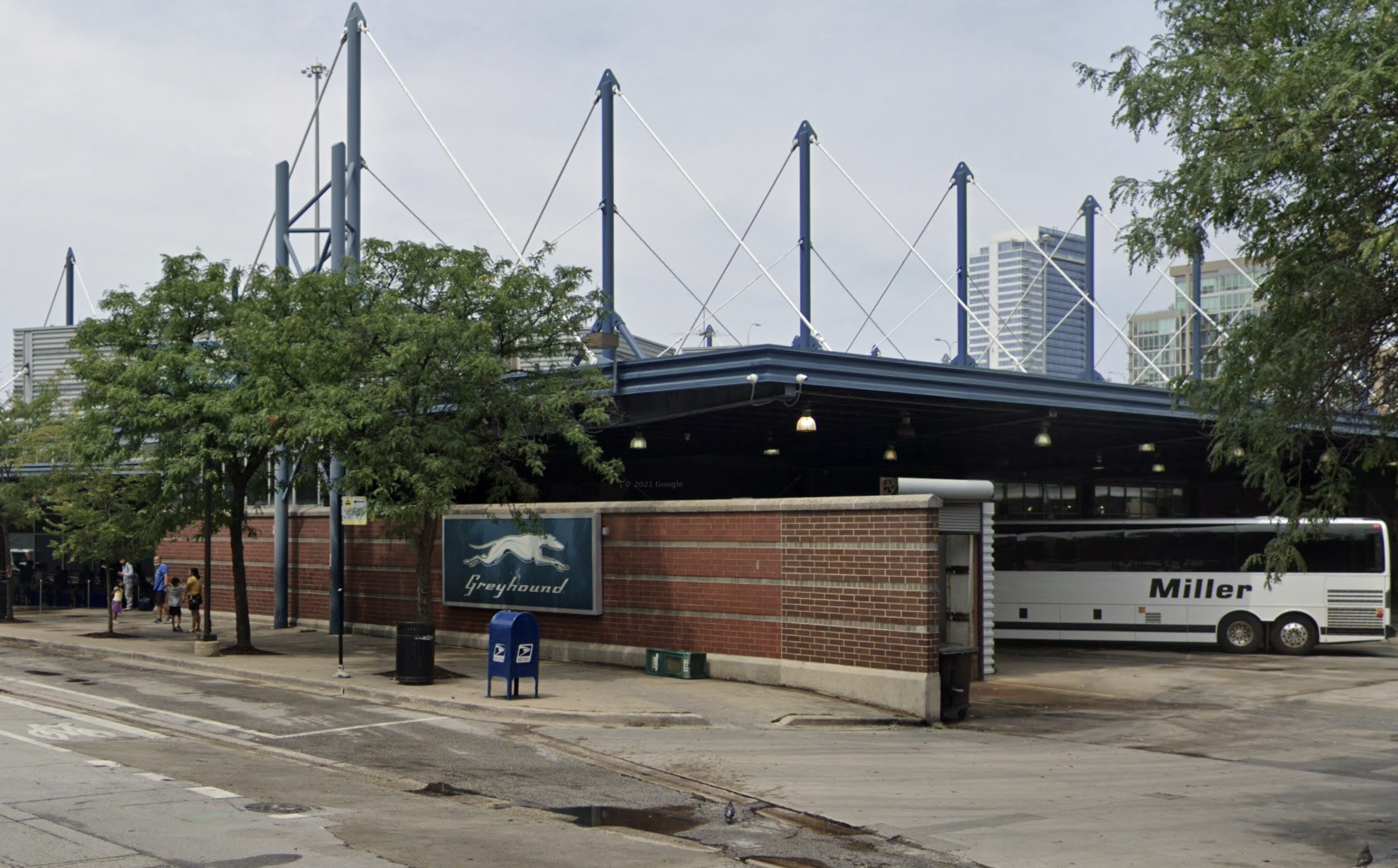
Read the Chaddick Institute policy brief here.
Take a look at HSRA's online campaign "Ask Mayor Johnson and Governor Pritzker to save the Chicago Greyhound Terminal."
Check out Better Streets' email campaign, "Urge Mayor Johnson to take immediate action to save intercity buses city bus service in Chicago."
Contact the office of local alderperson Bill Conway (43rd) to state your opinion on this issue.
Over 100 people, including a Chicago alderperson, transit professionals, and sustainable transportation advocates, participated in today's online discussion "Chicago's Intercity Bus Hub Is at Risk." The webinar was hosted by the High Speed Rail Alliance and the grassroots advocacy group Better Streets Chicago
As Streetsblog has previously discussed, the lease for the Chicago Greyhound terminal at 630 W. Harrison St. in the West Loop is slated to expire on October 1. In July, a team of 22 advocacy, community and civic groups called the Coalition to Save the Chicago Greyhound Terminal sent an open letter to Mayor Brandon Johnson asking him to be proactive about saving the station. They noted that intercity bus service is especially important for lower-income residents, travelers with disabilities, minority groups, students, and individuals who don't own cars or can't drive.
This morning, DePaul University's Chaddick Institute released a policy brief titled, "Chicago Is About to Become the Largest City in the Northern Hemisphere without an Intercity Bus Terminal." It was written by institute director Joe Schwieterman, along with Carrie Craig, Shamiso Gonbera, and Akshara Das. It warned, "The Windy City is set to join two warmer-weather places, both in the southern hemisphere, among the world's 130 largest cities without long-distance bus terminals."
"Chicago is on the verge of suffering a major blow to its transportation system," the invite to today's online discussion said, noting that the Greyhound terminal also serves Baron Bus, Trailways, and FlixBus. (Indian Trails has already stopped linking Chicago to Michigan, and other companies have expressed interest in serving Chicago – if there was a publicly owned station.) "Operations may be moved in mid-September to a congested curbside location, resulting in service cuts and significant reductions in the sale of 'through tickets' involving transfers in Chicago due to the lack of a waiting facility."

The on-street location in question would be the dedicated CTA bus lane on Jackson Boulevard next to Chicago Union Station. Another reason that's a terrible idea is because the intercity buses would obstruct local buses.
Today's panelists included Schwieterman; Gilda Brewton, head of public affairs for FlixBus; Ald. Carlos Ramirez-Rosa (35th); and Micheál Podgers, policy director at Better Streets.
Moderator HSRA Executive Director Rick Harnish kicked off the talk by explaining why his rail advocacy organization cares about intercity buses. "We're working for the entire integrated picture that makes it possible for people to leave their cars at home," he said. "Intercity buses have a critical role to play in that."
He called the approaching Greyhound terminal closure "a critical issue nationally, because in so many ways Chicago is the hub of transportation, and if bus service to and from Chicago declines, that'll cause a cascading effect across the entire country as fewer people use the intercity bus network. He added, "So the future of having an indoor, off-street bus terminal in the city is for us a very critical issue."
Harnish noted that the Central Illinois Regional Airport, the airport for Bloomington and Normal, carries roughly the same amount of people that Chicago's Greyhound station currently serves. The airport is considered important enough that a public authority was created to own and manage it. "Because [the airport is so important to that community, homeowners are supporting that authority with, if it's a $150,000 house, about $55 dollars a year [in taxes.]"
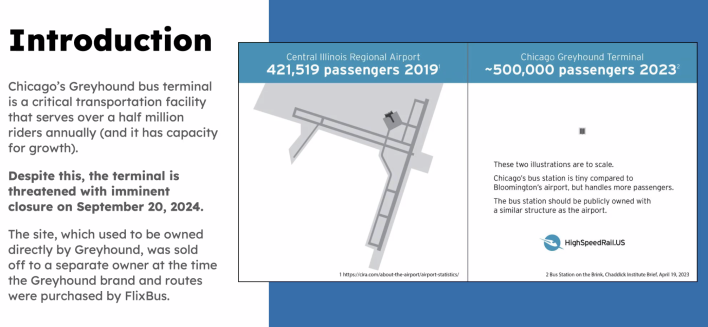
He pointed out that the airport covers an exponentially larger land area. "So we believe that that there should be a public entity of some nature [overseeing the bus station] and that Chicago should be very involved in making that happen, in order to make it possible for bus companies of all kinds to come in and serve the city and provide a key place for people to transfer."
Next was Schwieterman, who said Chicago's Greyhound station was built in 1989, called it, "mid-America's connecting hub." He presented a map showing the current state of routes into the terminal.
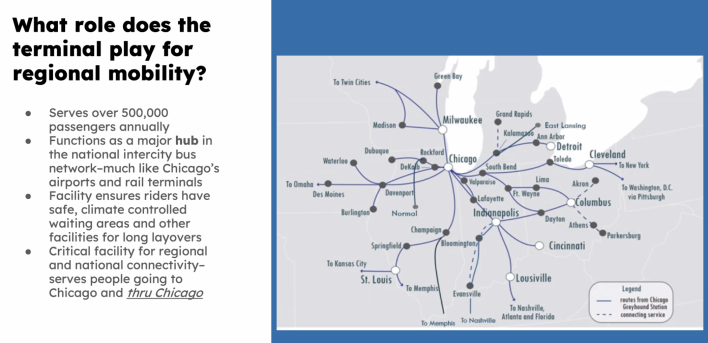
"You can see there's lots of places the train doesn't go," Schwieterman said. "There's a lot of synergy between the modes." He added that U.S. has something "unique and really tremendous," called the National Airline Bus Network. "About two dozen bus lines interconnect and you can buy a single ticket. So somebody, you could say, in Cleveland, is going to Omaha, and can buy a through ticket on Greyhound and connect to Trailways. It's a tremendous resource, critical to low-income populations. And recent numbers show that the majority of passengers have household incomes of less than $50,000."
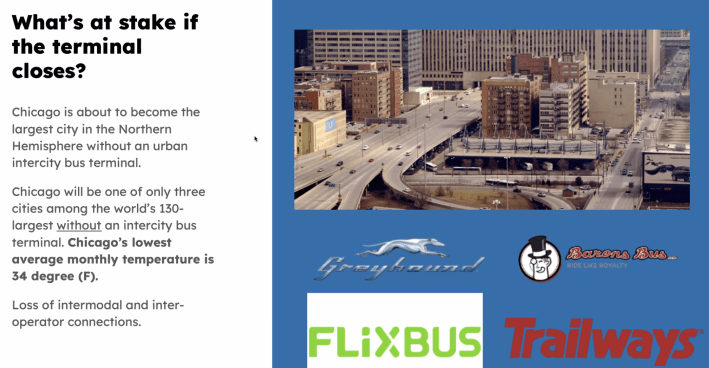
"And if you take Chicago out of the mix and move to curbside loading, as is being talked about, those connections could probably never be sold," Schwieterman added. "You simply can't drop someone off in the street in January and say, 'Wait here three hours in the snow'... The loss of this station, by limiting through traffic will by consequence result in pretty major service cuts, and a lot of routes will no longer be viable."
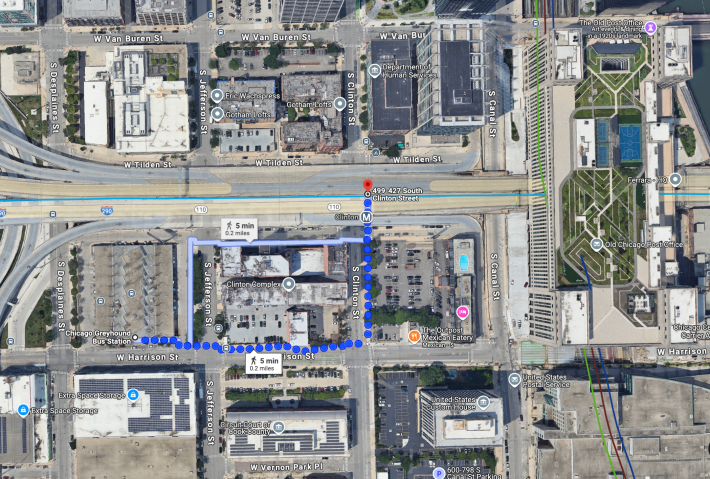
Schwieterman discussed the current status of the station, which he said has about 20 bus bays, and is near the Clinton Blue Line station. "The location has actually gotten a lot better in the last five or six years because of the Old Post Office reopening, a lot of residential development that way, some South Loop and Union Station development." He said the terminal "is pretty modern" with indoor vending, a snack bar, and "clean restrooms." He said it's believed that the building can be purchased for $20-30 million, a relative pittance.
"I think in the United States this problem is partly occurring because we are kind of alone in having a privately owned stations in which the entire burden of the facility in borne by bus lines," Schwieterman concluded. "And the property tax on this station alone, paid by Greyhound, has topped $120,000 a year in the past. So public involvement in preserving this station, whether it's a lease extension, financial support for the station, options to bring it under public ownership with perhaps county and public transit agency involvement are really important. And so we're quite upset that there doesn't appear to be a technical analysis of our options as the looming deadline comes."
After that, Gilda Brewton from FlixBus, a German-based company that bought Greyhound in October 2021, spoke. She said it's important that "we continue talks and have a plan in place" regarding the station closure because "time is running out and we are in a dire situation... September 20 is our date that we should be out of the facility."
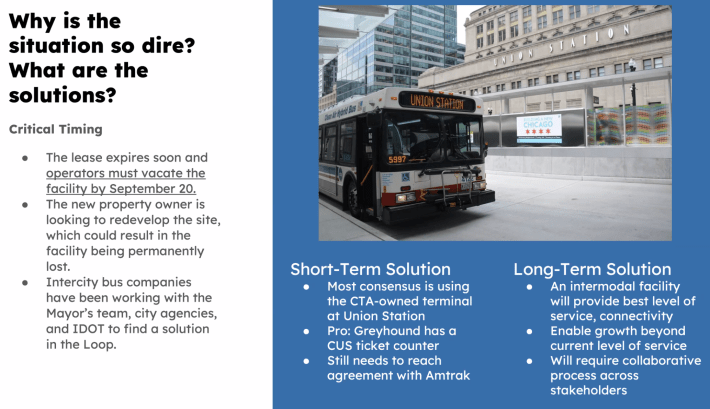
"When we vacate that facility, short term, we are looking at [Jackson Boulevard], adjacent to Union Station," Brewton said. She noted that Greyhound already has a ticket counter inside the train station.
"We've been working with the Mayor's Office... City agencies, and [the Illinois Department of Transportation] to find a solution in the Loop," Brewton concluded. "Again, the short-term would be [Union Station], and then long-term solution would be an intermodal such as the ones in Los Angeles and New York City."
Next up was Ald Ramirez-Rosa, who said decision-makers have discussed the concept of having intercity bus customers use Union Station as a waiting area. However, "In my conversations with Amtrak, they have made it clear, in no uncertain terms, that they are not prepared to accept all of Greyhound, now Flix North America's passengers within Union Station. Union Station is owned and operated by Amtrak. If you've been by there during rush hour, you know just how packed it gets. Every single chair, every singe table is full of people. The bathrooms are full. And Amtrak is set to begin a billion-dollar-plus renovation of their facility next year."
Ald. Ramirez-Rosa added that currently outside Union Station there are lots of Uber and Lyft drivers and civilians dropping off and picking up train riders and idling. "So you can imagine what would happen if all those vehicles were added to an already congested Jackson Boulevard. In addition to that you would have all of the additional passengers that would be inside Union Station."
"I have been pushing the City internally to really bring all stakeholders together, Ald. Ramirez-Rosa said. "To ensure that we're figuring out, what is the short-term solution that really meets the needs of the poor and working-class people who rely on Greyhound for their transportation needs. So many of them are returning citizens... so many of them are poor or working-class people who have no other way to reach their loved ones in small and mid-sized towns and cities."
The alder added that he thought Amtrak and the City of Chicago may have been meeting at the same time as the webinar. "Hopefully that meeting goes well." He said possible alternatives to Union Station include the Metra commuter rail hubs LaSalle Street Station and the Ogilvie Transportation Center, which has retail space vacancies.
Ald. Ramirez-Rosa said he and Ald. Daniel La Spata (1st), chair of the City Council's Pedestrian and Traffic Safety Committee, filed a resolution urging the City to think more creatively about the bus station problem. "We're hoping that in September the resolution will be heard in the committee, and it will be an opportunity for stakeholders to come together and talk about what are the short-term and long-term solutions." He floated the idea of the City leveraging a developer for a Community Benefits Agreement to create a mixed-used development at the current Greyhound site, with an intermodal station, retail, and housing.
After that, Micheál Podgers from Better Streets had a few final comments about "some of the more intangible aspects of what it means to lose this terminal." He noted that, along with smaller towns and rural areas, some medium-sized cities like Madison, WI are primarily connected with other cities through coach buses.
Podgers noted that buses are also key for people trying to access legal abortions and other reproductive heath resources. "[Illinois] is surrounded by a lot of states that have added restrictions, and there's been a massive increase in the number of people traveling to Illinois to get these services." He said that many of these people are lower income, from smaller communities, or are uncomfortable flying and prefer buses.
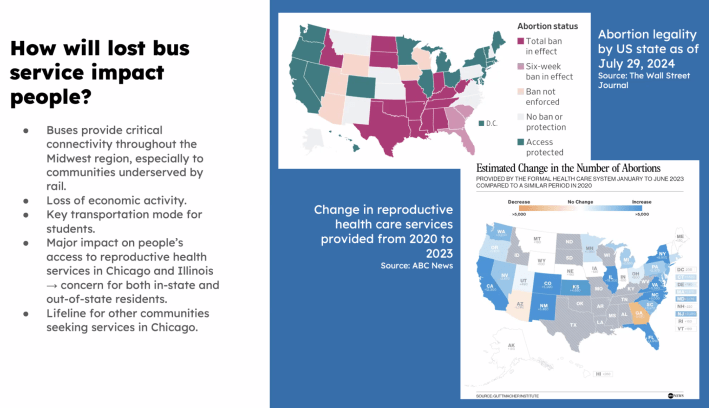
He added that Chicago "is a destination for the LGTBQ community, and all sorts of healthcare services. Our city's size means that we can have a lot more of these amenities available. And very often people are taking the bus to get to these services."
Podgers noted that, in addition to HSRA's online campaign "Ask Mayor Johnson and Governor Pritzker to save the Chicago Greyhound Terminal" Better Streets is currently hosting an email campaign on the bus issue.

In the Zoom chat, Streetsblog asked if Ald. Bill Conway (34th), who represents the Greyhound station's district, has been involved in efforts to shut down the terminal in favor of development, or to save the station. During the Q & A, Ald. Ramirez-Rosa addressed that question. (In June 2023, the Sun-Times reported, "Local Ald. Bill Conway (34th) supports moving Greyhound’s station elsewhere.")
"We obviously have a system of aldermanic prerogative... where when there are zoning and land-use decisions that are being made, the Council defers to one another," Ald. Ramirez-Rosa said. "That said, it's a little bit different when it comes to large, major, citywide developments like this one. So it's not uncommon, particularly in and around the Central Business District, to see the Mayor's Office play a bigger role, and to see other aldermen weigh in on these bigger, more important issues as well."
"So I don't know where Ald. Bill Conway stands on this specific issue," Ald. Ramirez-Rosa concluded. "I certainly hope that he supports a... bus terminal at the existing site. I think that as you look at the various different options downtown, this is a very attractive option, particularly if you're able to open up [a] tunnel between the Clinton Blue Line stop and Amtrak's Union Station... So I think the existing site is a very good option, and I know many of the experts who have looked at it as well say that this a great option that should be maintained in the long-term."
Read the Chaddick Institute policy brief here.
Take a look at HSRA's online campaign "Ask Mayor Johnson and Governor Pritzker to save the Chicago Greyhound Terminal."
Check out Better Streets' email campaign, "Urge Mayor Johnson to take immediate action to save intercity buses city bus service in Chicago."
Contact the office of local alderperson Bill Conway (43rd) to state your opinion on this issue.

Did you appreciate this post? Please consider making a tax-deductible donation, to help keep Streetsblog Chicago's sustainable transportation news and advocacy articles paywall-free.
